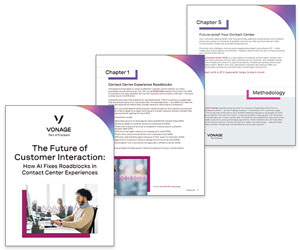Ryan Yee at Vonage explains what Conversational AI is, and how it can help your business.
When you hear the term conversational artificial intelligence (AI), do you automatically think of chatbots? It’s a logical leap. The best chatbots leverage AI, but not all do. Plus, conversational AI powers more communication solutions beyond just chatbots.
What Is Conversational AI?
Conversational AI combines various AI strategies to enable computers to communicate with humans like humans. This technology can analyze human speech and written text across different languages, interpret meaning and context, and respond in a way that mimics human dialogue.
It can make your chatbots smarter. It’s also what powers virtual personal assistants such as Siri and Alexa. The technology enhances voice assistants and interactive voice response (IVR) applications by freeing them from scripts — and by freeing customers from phone trees.
Rather than offering incoming callers a list of options from which to choose, an AI voice assistant lets your customers ask questions or explain their needs in their own words.
This type of AI is often used for customer service and contact centres, but these tools can also be integrated into your company websites, ecommerce platforms, social media channels, and digital marketing platforms.
How Does Conversational AI Work?
These solutions combine advanced AI technologies such as natural language processing (NLP), automated speech recognition (ASR), and machine learning (ML) to interact with humans and learn from those conversations, improving the quality of interactions over time.
This can be broken down into several key steps:
- The human provides input. The AI receives information from the human via voice or text.
- The AI analyzes the input. For text-based conversations, the AI uses natural language understanding (NLU) to determine meaning and identify intent. For voice conversations, the AI applies ASR to translate voice messages into machine readable text, then uses NLU to analyze it
- The AI formulates a response. Using natural language generation (NLG), the AI responds in a way that mimics human speech or text.
- The AI learns and improves. The AI leverages ML algorithms to “learn” from each interaction — so it better understands the nuance of human conversion over time and can respond more accurately and conversationally.
What Are Chatbots?
A chatbot is software that conducts conversations with users online via text or text converted into speech. It can interact with your customers on any text-based platform, including SMS, social media, and messaging apps. Using chatbot APIs, you can even add these solutions to your website, ecommerce site, or other online properties.
Not all chatbots are created equal, nor do they all have the ability to learn. Traditional rules-based chatbots are scripted by humans and told what to say in specific scenarios or in response to defined keywords.
An AI chatbot employs AI technology and can tap into other data sources — such as customer history and behavioral data — and thus needs no script.
Conversational AI vs. Chatbot
The terms “conversational AI” and “chatbot” are often used interchangeably, but they’re not the same thing. Here is a guide to their key differences:
| Traditional Chatbot | Conversational AI |
|---|---|
| Text-based communication | Omnichannel communication |
| Uses rules-based programming to identify keywords | Uses ASR and NLU to understand user’s questions or needs |
| Responds from script | Formulates responses in real-time |
| Limited understanding/responses that may frustrate users who don’t use the right keywords | Understands user’s meaning and leverages contextual data from other interactions to respond to any query |
| Static solution | Dynamic solution that improves over time |
Benefits of Conversational AI
Chatbots, voice assistants, and other similar AI applications offer you several benefits:
Improve Customer Service Experience
Chatbots and AI-enhanced voice assistants provide prompt, 24/7 service. Your customers can avoid phone trees and long wait times and get fast answers to questions of all kinds.
The technology can be used across channels, meeting customers where they are and with context from previous interactions.
Meanwhile, human agents spend less time answering simple questions, giving them more time to help customers with complex needs.
Manage 1:1 Conversations at Scale
Conversational AI-backed chatbots can pull data from a variety of sources, including customer relationship management platforms, customer profiles, and purchase history.
They don’t just understand what your customer is saying; they know who your customer is and how they’ve interacted with your brand in the past.
The AI can use this information to personalize interactions, anticipate needs, make recommendations, and remember all this information for next time — and do it in multiple languages on a global scale.
Convert Social Messaging Into a Fully Fledged Store
With the right integrations, chatbots and voice assistants can complete secure transactions without redirecting them to an ecommerce site or live agent.
If a customer is intrigued by your social messaging, they can engage your social media chatbot and complete a purchase without ever leaving the original social post.
Turn Conversations Into Points of Sale
After your AI handles whatever business your customer has in mind, it can take the opportunity to upsell or cross-sell products and complete those transactions on the spot.
Say a customer has purchased your software and reaches out with questions about how to use it. The AI can provide a tutorial and then recommend complementary software or additional functionality that might be useful for the customer.
Omnipresence Across Omnichannel
Whether a customer calls in and talks to your voice assistant, texts with a chatbot via SMS, or messages with a chatbot on any popular messaging app, the customer is talking to the same AI.
It recognizes the customer, remembers the last interaction, and applies that context to the current one. It’s a seamless omnichannel experience, personalized for each unique customer.
How to Implement Conversational AI
Think of the AI technology as programmable building blocks that can help you power successful customer interactions. You don’t implement it by itself — you implement tools that have the technology built into them.
For example, the Vonage Voice API lets you deploy self-service tools that are customized to your business and can be added across channels, from your business phone system or contact centre platform to your website, mobile app, and social media pages.
And Vonage’s Jumper.ai platform enhances the omnichannel outreach enabled by our APIs with AI-driven, two-way conversations across social, messaging, and the web.
As you deploy voice assistants or chatbots, consider the following:
- Customer journey. Where do customers interact with your brand, and how can AI add value at each of these touchpoints?
- Company goals. Are you implementing AI to improve sales, bolster digital marketing efforts, streamline customer service, or all of the above? Which tools can help you accomplish these goals?
- Integrations. Which databases or key business applications have important data that your AI can tap into to personalize the customer experience?
- Live transfers. Perhaps the most important best practice for conversational AIs is giving customers the option to talk to a live person and to make that transfer as seamless as possible.
Simply put, keep your customers’ needs top of mind as you formulate an implementation strategy for your business, and your AI will help you meet them.
This blog post has been re-published by kind permission of Vonage – View the Original Article
For more information about Vonage - visit the Vonage Website
Call Centre Helper is not responsible for the content of these guest blog posts. The opinions expressed in this article are those of the author, and do not necessarily reflect those of Call Centre Helper.
Author: Vonage
Published On: 8th Sep 2022
Read more about - Guest Blogs, Vonage






 Vonage is redefining business communications, helping enterprises use fully-integrated unified communications, contact centre and programmable communications solutions via APIs.
Vonage is redefining business communications, helping enterprises use fully-integrated unified communications, contact centre and programmable communications solutions via APIs. 












